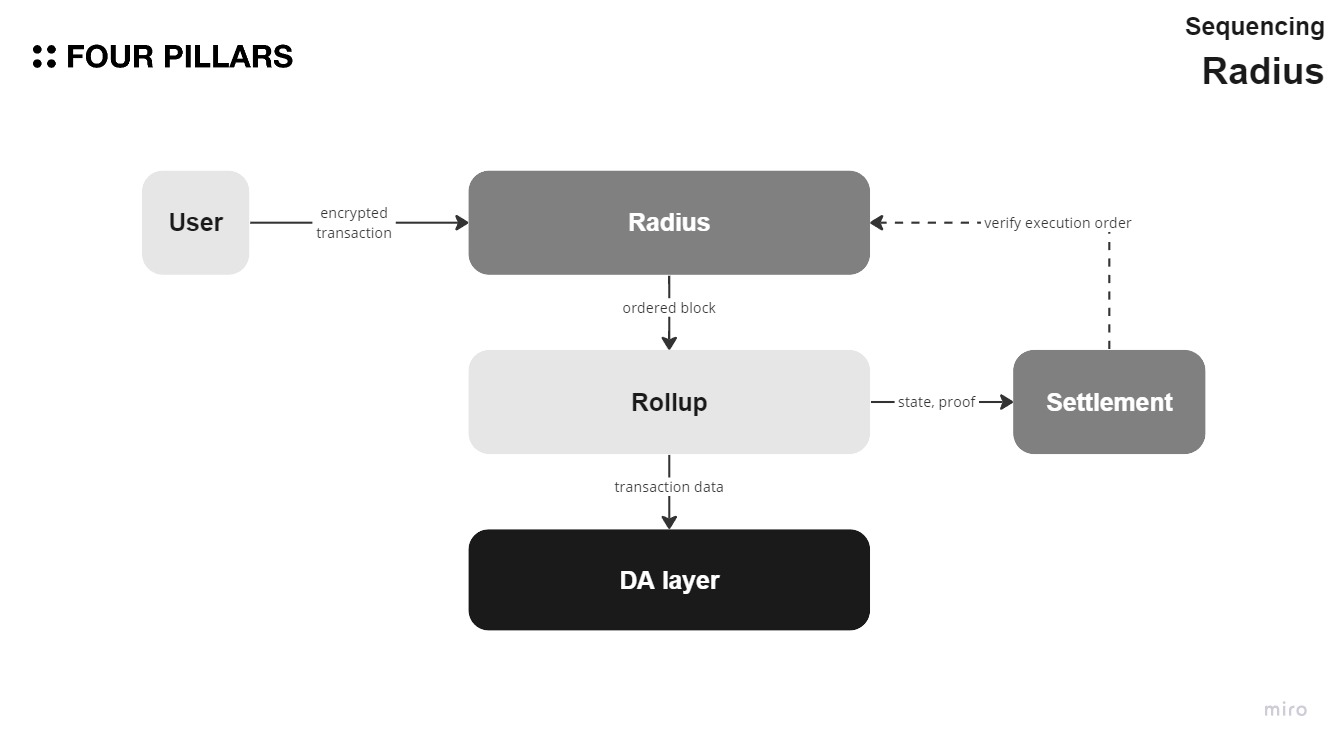Radius
Key Takeaways
- Radius is a shared sequencing layer that utilizes PVDE (Practical Verifiable Delay Encryption), eliminating harmful MEV and censorship even with a single sequencer.
- The content of users' transactions is only disclosed after sequencing, so even a single sequencer can't act maliciously in the first place.
- Radius is blockchain-agnostic, which means it can be used as a sequencing layer by various L1, L2, and L3 networks.
1. Overview

Radius is a shared sequencing layer, and its main feature is that it utilizes a technology called Practical Verifiable Delay Encryption (PVDE). With this, it can eliminate harmful MEV and censorship even with just a single sequencer.
The content of users' transactions that come into Radius is only disclosed after being sequenced. This is made possible by temporarily encrypting the transaction based on a time-lock puzzle. This scheme delays the time it takes to find the symmetric key needed to decrypt the transaction. However, because it takes significant computational resources to solve the time-lock puzzle, it uses zero-knowledge proofs to prove the validity of the time-lock puzzle to prevent malicious DoS attacks.
Even without multiple sequencers, the sequencer cannot maliciously extract MEV or censor transactions as it can't know the content of the user's transactions. Radius offers 1) Encryption-as-a-Service, 2) Sequencing-as-a-Service solutions, and additionally provides 3) an open marketplace known as a Benign MEV Provider. This allows traders or searchers to extract MEV through cross-rollup arbitrage, liquidations, and back-runs, and a portion of this revenue is returned to the ecosystem.
2. Transaction Lifecycle
The transaction lifecycle of a rollup network using Radius as a sequencing layer is as follows:
- Users submit encrypted transactions and corresponding proofs to Radius(sequencing layer).
- The sequencer verifies the proof to check the validity of users’ transactions.
- The sequencer sequences verified transactions.
- The sequencer decrypts the transaction and builds a block, and then the block is submitted to the rollup(execution layer).
- The rollup receives the block and executes it in the given order.
- The rollup submits 1) the results and proof of the state to the settlement layer and 2) transaction data to the data availability layer.
- Lastly, Radius checks if the execution order matches the order provided through the settlement layer.
3. Sequencing
Unlike other sequencing layers, Radius fundamentally uses a single sequencer. It can resolve the MEV and censorship issues from a single sequencer because it encrypts users' transactions through PVDE (Practical Verifiable Delay Encryption). However, there might be a liveness failure if only one sequencer is running. To prevent this, it employs a system with a single sequencer elected from multiple sequencers at regular epochs. The single sequencer is one of Radius's significant advantages, as there's no need to introduce an additional consensus mechanism, which can reduce scalability degradation from consensus.
4. Data Availability
(TBA)
5. Use Cases
Radius is a blockchain-agnostic sequencing layer and can provide sequenced blocks to various networks such as 1) L3 based on Starknet, zkSync, Optimism, Arbitrum, Polygon, 2) L2 made with StarkEx, Op Stack, Saga, Rollkit, and 3) L1 made with the Cosmos SDK. Specifically, Radius is expected to be one of Madara's (RaaS service in Starknet ecosystem) many sequencer solutions.
